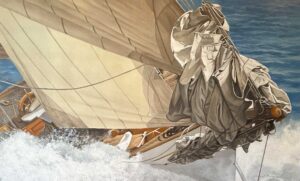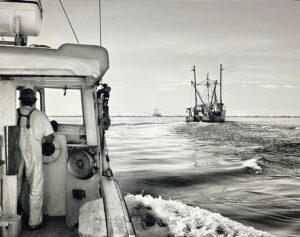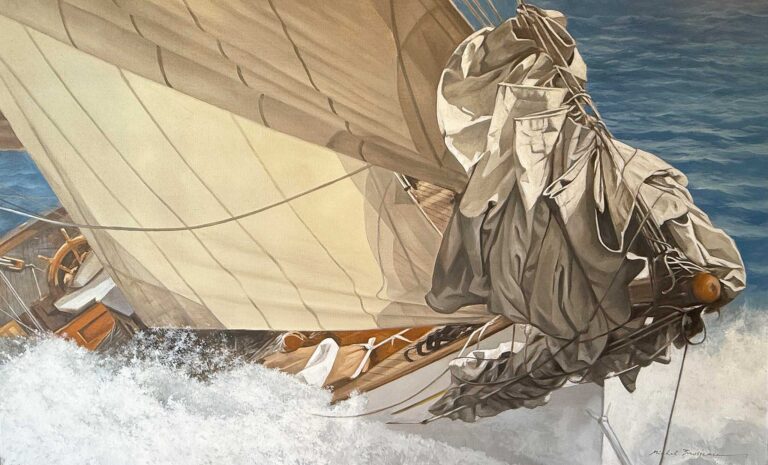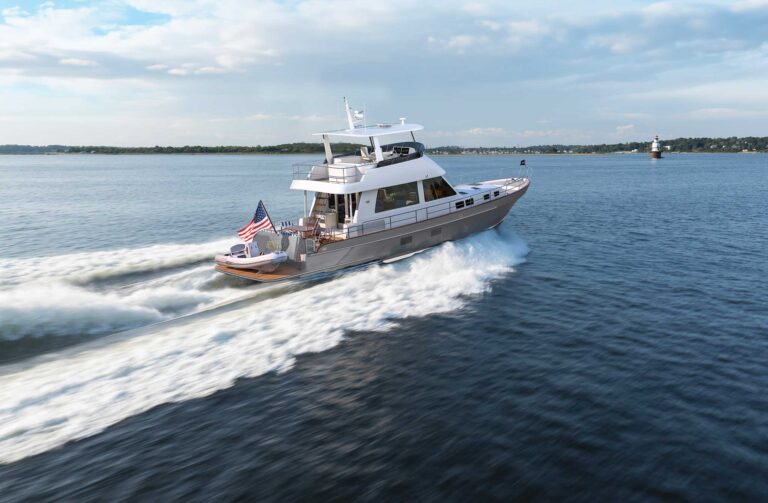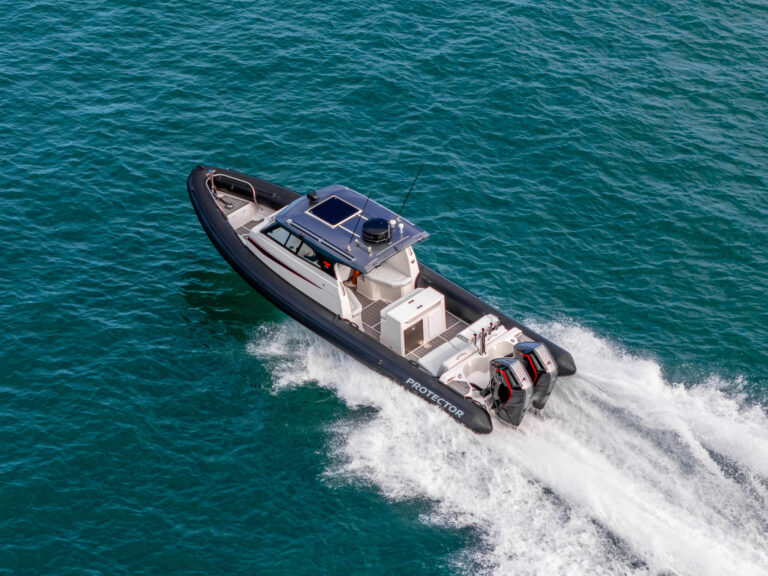A stroll on the docks is always more than that. It’s therapy, it’s research and often there’s that nudge of inspiration. And every now and then the hippocampus twitches with pangs of envy, especially when staring at a vessel that makes the jaw go slack, like the cutter Vito Dumas that lives on A-Dock at Boat Haven in Port Townsend, Washington.
Easy on the eye and full of sensible details, her low freeboard and deckhouse blend perfectly with her elegant sheer, just as one might expect from designs by William Atkin or Colin Archer, but Vito Dumas came off the drawing board of Manuel Campos. An autodidact and one of Argentina’s preeminent yacht designers of the last century, Campos was no stranger to the work of Archer and Atkin, but also was influenced by balleneras, double-ended craft with whaleboat heritage that plied the shallow waters of the River Plate.

Since his death in 1987, Campos’ name has slipped from collective memory, even though he designed one of the most famous small oceangoing boats of all time, the 31-foot ketch Lehg II. It carried Argentine solo sailor Vito Dumas around the world. Sailing in the Roaring Forties with stops in Cape Town, Wellington, Valparaiso, Mar Del Plata and Montevideo, Dumas’ effort was a daring exploit, something never attempted before. That historic feat—accomplished in 1942 and 1943 at the height of World War II—immediately established Dumas as a celebrity upon his triumphant return to Buenos Aires.
When we think about the pantheon of famous solo circumnavigators, it’s easy to rattle off the names of giants who defined the genre: American Joshua Slocum, the British Sirs Francis Chichester and Robin Knox-Johnston, or the Frenchman Bernard Moitessier. They were larger-than-life characters, resourceful skippers and authors of seminal books. Vito Dumas, his daring voyage on a small and sparsely equipped ketch and the book he wrote about it (Alone Through the Roaring Forties) certainly have a seat at this illustrious table. Years later, the national-socialist Perón regime co-opted him for propaganda reasons, which tainted Dumas’ name, but for a while monuments were erected and boats were christened in his honor. Like that pretty cutter on A-Dock in Port Townsend.

“Originally the boat was called Irupé, but I only found out later,” reveals Alex Spear, who has owned this 31-foot beauty since 1976 and covered some 30,000 miles since then, leaving Mexico, the South Pacific, French Polynesia, Hawaii and Alaska in his wake, before tying up in Port Townsend, which became his home in the early 1980s. Spear, a native of Southern California who’s been sailing since childhood, studied environmental biology, anthropology and philosophy of religion, but then took a liking to carpentry, which he learned from a Finnish boatbuilder while on a study trip abroad.
“My boat was built in 1933 at the Parodi yard near Buenos Aires, as a gaff cutter for Dr. Ballestra, a neurosurgeon,” Spear says. At the same time, the construction of Lehg II was just getting under way, so it is likely that Irupé, which greatly impressed Dumas, inspired the lines of Lehg II. While Irupé never acquired Lehg II’s fame, she still sails, using the same Marconi rig that Germán Frers Sr., another celebrated Argentine yacht designer, drew for her in the 1940s.
Fast forward three decades to the early 1970s, when the boat was renamed Vito Dumas by her then-owners, Julio and Pepe Ozan, who sailed the boat from Argentina to San Diego and sold it to Mike Logg for $12,000 (about $58,000 in 2021). Right around that time, Spear had graduated from college and was looking for a boat with his friend Mike Bair, who just had gone through a divorce. They came across the vessel, which was already for sale again, after Logg had 20 planks replaced but lost his drive for all the work the boat still needed.

Cockpit, toerails, bulwarks, side deck, tanks and fittings had to be replaced. It was a lot of work, but Spear and Bair agreed that this boat was worth it. They had carpentry skills and a friendly shipwright who lent a hand and good advice. They paid Logg $16,000 (about $73,000 in 2021), and went to work. After six months, Vito Dumas looked as good as new. They had about $4,000 left in the budget to provision and kit her out with new standing and running rigging and a genoa. Their first trip led them to the Channel Islands north of Los Angeles, where they met the 15-meter ketch San Juan, another Campos design. “Compared to Vito she was gigantic,” recalls Spear. “But there were a number of similarities in her fittings, interior and styling.”
After sailing to Mexico and the South Pacific, Spear and Bair parted company in Hawaii in 1979. Spear bought out his friend’s share and sailed Vito Dumas back to the West Coast via Alaska, Haida Gwaii and the Inside Passage. One of the first stops in the Lower 48s was Port Townsend, where he met a surprising number of people he’d first seen during the Pacific voyage, so coming here several years later was like coming home.
Now retired, Spear averages about half a dozen trips per year to destinations north of the border such as Desolation Sound, the west coast of Vancouver Island and the San Juan Islands. On longer tours, he joins his friend and sailing buddy Russell Brown, a boat builder and multihull sailor who crossed the Pacific on a proa and currently holds the single-handed record in the Race to Alaska with his 32-foot catamaran Incognito.

Spear and Brown travel separately but anchor together. It’s hard to find two boats that are more different: Vito Dumas, a heavy sloop with a long keel and a hull speed of approximately 6 knots, and Incognito, a svelte multihull that easily does twice that speed. “Either he takes off later or goes on a detour before we arrange to meet,” laughs Spear. “It’s the tortoise and the hare.” But the party always happens at the tortoise’s place, meaning dinner and drinks are served in Vito’s cozy salon of varnished Paraguayan cedar, with a wood fire crackling in the galley’s blue enamel stove.
“Alex and I have been cruising together for 25 years,” says Brown. “I’ve grown very fond of him and Vito Dumas. We’ve had some tremendous adventures, influenced by Alex’s seamanship, style and unique sense of how to enjoy and respect beautiful places.” But despite its traditional lines and heavy displacement, Vito is a force on the race course. “Sailing her off the wind in big waves is a dream,” raves Brown. “She never feels especially fast, but she’s always up there in front.”

Vito Dumas is not a “goldplater” as Spear puts it, or a museum piece. Well maintained, she wears the scars of time with dignity. Little things that easily go unnoticed add up to make a big difference, Spear explains. “The idea was improvement without disturbing the big picture.” Spear was able to create a balanced blend of old and new on the boat, and that required skill and deliberation.
The martial anchor windlass on the bow is original. The three-strand rope that runs through the wooden blocks is new, but reminiscent of the cordage used in the 1930s. The old galvanized steel fittings gave way to solid bronze copies that carry the bespoke patina, so they too blend in perfectly. The analog engine instruments under the bridge deck invoke the days the boat was built, but they take the pulse of a contemporary 15-hp Volvo diesel that turns a low-resistance Maxprop feathering propeller. And the original Dolphin winches with folding handles, which lacked the strength to crank genoa sheets, moved from the cockpit coaming to the cabin top to handle the stays’l trim.
Structurally, there was a lot to improve because some of the work done way back when wasn’t up to snuff. Working with shipwright Arren Day, Spear replanked the hull with sapele. “We left the sheer plank in place and pulled off three courses stem to stern and noticed a lot of weird repairs, short planks and fastening issues,” he says. “And I removed all iron fasteners from the hull.” He also reframed the bilge area, laminated in some locust frames under the salon, strengthened the forward floors to arrest keel movement and added the ceiling pieces that cover the hull and frames up to the cabinetry.
“There is no doubt, she is structurally stronger than the day she was launched,” says Spear. “By rebuilding, I almost built a new boat.” But you’d never notice, standing before Vito Dumas full of admiration, and more than just a pang of envy.
VITO DUMAS Specifications
Year Built: 1933
LOA: 40’0″
Beam: 10’4″
Draft: 4’6″
Sail Area: 600 sq. ft.
Displ.: 17,000 lbs.
Engine: 15-hp Volvo diesel
Builder: Parodi Bros.
Artist, Athlete, Sailing Hero
When we think about the pantheon of famous solo circumnavigators, it’s easy to rattle off the names of giants who defined the genre: American Joshua Slocum, the British Sirs Francis Chichester and Robin Knox-Johnston, or the Frenchman Bernard Moitessier. They were larger-than-life characters, resourceful skippers and authors of seminal books. Vito Dumas, his daring voyage on a small and sparsely equipped ketch and the book he wrote about it, certainly have a seat at this illustrious table.
Born on September 26, 1900, as the son of a poor tailor in Buenos Aires, Dumas had an artistic bent, which he later expressed in drawings of his circumnavigation. But before he became an ocean sailor he was a competitive swimmer, who tried but failed to gain fame and notoriety with long-distance crossings of the English Channel or the River Plate.
He switched to sailing and undertook his first singlehanded ocean crossing from France to Argentina in 1931 on a rather unsuitable 8-Meter racing yacht Lehg, a name that’s allegedly made up from the initials of a wealthy mistress who supported him financially. But Dumas and Lehg II, the Marconi ketch that carried neither engine nor wind vane, proved to be equal to the task and conquered the hearts of the Argentinean people who might have been spared the worst of World War II, but still desired heroes they could identify with.
For his boat that was designed by Manuel Campos, Dumas had nothing but the highest praise.
“What could I have done on this desolate route, had I not been able to rely upon a suitable craft?” he wrote in Alone Through the Roaring Forties. “Sudden disaster is always around the corner at sea; danger lies everywhere in the waves, mast, sails, rigging, deck; the possible causes of failure could extend indefinitely. The truth is that success is the reward of a harmonious combination of factors contributing to the desired result… thanks to her robust build and her first-class sailing qualities, she gave me full and complete satisfaction.”
This article was originally published in the June 2021 issue.


